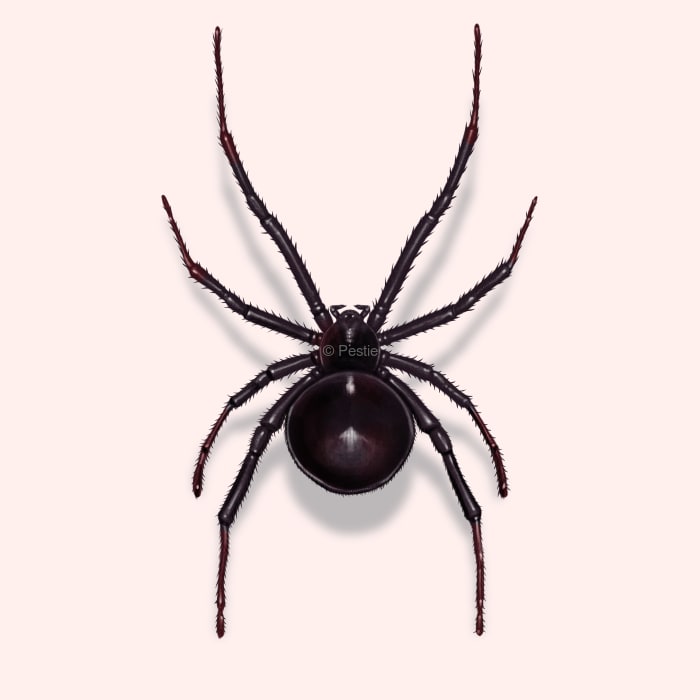How to identify and get rid of widow spiders

The red hourglass warning: keeping black widows at bay
Getting named for the fact that you are likely to eat your mate is no joking matter. Add a black colored body with an ominous red symbol, and nobody dares to mess with you!
Black widows can frighten many homeowners who neglect to clean up the cobwebs in the forgotten corners of their garages, attics, or outdoor structures.
These spiders are shy and solitary, only socializing during mating. They prefer dark, undisturbed corners to construct their webs. They typically hang upside down, displaying the red hourglass marking on their abdomen. This marking is a warning sign that this spider is venomous, so keeping your distance is a good idea.
Black widows inject a powerful neurotoxin into their prey, and that same neurotoxin can cause complications when they bite humans. While fatality are extremely rare from a black widow bite, the bite itself is extremely painful, and the symptoms are uncomfortable.
How to identify black widows
Black widows are infamously marked with a red hourglass shape on the underside of their abdomen. Females are shiny and black but seem to stand out in their messy, tangled webs.
Male black widows are typically smaller than females, reaching only about half their size in length. However, their legs are proportionately longer and are marked by orange and brown at the joints. The males may also have red and white stripes on the abdomen, which can vary depending on the species, and are more brightly colored and intricately patterned than the females.
How big are black widows?
Females, which are typically the ones you need to watch out for, can be about 1.5 inches long when including their leg span.
What other pest looks like a black widow?
False black widow spiders share some similarities but lack the bright red hourglass marking. They're also less shiny and more brownish.
Where do black widow spiders live?
Black widow spiders are found across the United States but are more common in the southern and western parts. Look for them in dark and undisturbed locations inside or around the house. This can include under furniture, garages and attics, sheds, and outdoor structures.
How to get rid of black widow spiders
If you happen to find messy cobwebs in corners and an egg sac ready to burst with new little black widows, it’s time to take some action.
Here are a few ways to prevent black widows from settling in:
- Remove clutter: This reduces their hiding spots in your home and yard.
- Seal cracks and crevices: To prevent them from entering your home.
- Wear gloves: When moving things in storage areas to avoid accidental bites.
- Regular cleaning: Vacuuming and sweeping can help remove spiders, webs, and egg sacs.
- Perimeter spray: Use a perimeter spray to stop spiders from moving in by building your bug barrier.
Pestie offers a pro-grade DIY solution that keeps your property bug-free all year! Get your custom plan here.
Treat black widow spiders with Pestie
If you're still having trouble keeping black widow spiders away, the best option is to use a pro-grade, effective pest control solution like Pestie.
Pestie is a do-it-yourself pest control solution that's specially designed to keep black widow spiders and other pests away from your home.
With Pestie, you can rest easy knowing that your living space is protected and free of creepy crawlies. And the best part? It's designed for people, pets, and the planet, so you can say goodbye to harsh chemicals and hello to peace of mind!
- Save hundreds compared to traditional annual pest plans
- People, pet, and planet-friendly
- Pro-grade customized formulas
Quick facts
How dangerous are Black Widow Spiders?
High danger risk
Black widow venom is potent and can cause significant health issues, especially in young children, the elderly, or those with health conditions. Bites are rare, but medical attention should be sought immediately if bitten. Symptoms of a black widow bite include muscle cramps, seizures, chills and fever, nausea and vomiting, and a headache.
If you suspect a black widow has bitten you, seek emergency care immediately.
- Scientific name
Latrodectus Mactans
- Other common names
Southern Black Widows, Shoe-Button Spiders
- Colors
Shiny black with red hourglass mark
- Life span
Up to 3 years
- Diet
Insects
The venom of a black widow is 15 times stronger than a rattlesnake's, but don't panic! The amount of venom they inject is small, and it's highly unlikely their bite will be fatal to humans.








